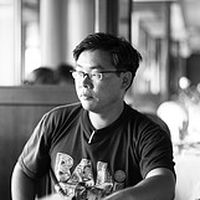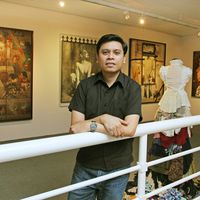How can creative freelancers make the most of social media?
 [caption id="attachment_51534" align="aligncenter" width="517"]
[caption id="attachment_51534" align="aligncenter" width="517"]Throughout 2015, culture360 contributor Claire Rosslyn Wilson will explore freelancing in the creative industries in Asia and Europe. Each article will look at an aspect of running a creative business, talking to freelancers to gain an insight of how they face common challenges.
In a context where online technologies have become a vital part of daily work, social media platforms have become increasingly influential. Used to build networks, get jobs, publicise or even exhibit work, these platforms provide easy-to-use tools that creative freelancers can take advantage of. This article will look at potential benefits of social media, followed by a look at how freelance writer Benjamin Law makes the most of his Twitter profile.
The rise of online technologies
There has been an unmistakable rise in the use of online technologies, but it has not increased equally across the world. Although the average internet use in the European Union is 75 out of every 100 people, there are still over five billion people who have never used the internet.[1]
[caption id="attachment_51535" align="aligncenter" width="507"]
 Source: World Bank, 2013[/caption]
Source: World Bank, 2013[/caption]Source: World Bank, 2013, http://data.worldbank.org/indicator/IT.NET.USER.P2
This inequality of access is particularly concerning as information and communication technologies become ever more pervasive in daily life.
[caption id="attachment_51536" align="aligncenter" width="498"]
 Source: World Bank, 2013[/caption]
Source: World Bank, 2013[/caption]Source: World Bank, 2013, http://data.worldbank.org/indicator/IT.NET.USER.P2
In spite of this concerning picture, there are four areas of opportunity due to the rise in online technologies in developing and developed countries alike[2]:
- Capitalising on the potential speed and cheap access to technologies
- The democratic access that could alter the top-down approach to interaction and knowledge production
- The drastic increase in mobile technologies and the rise of citizen journalism
- Social networks that allow information to be shared by anyone across the globe almost instantaneously.
These four points are also relevant for creative freelancers who are often working outside institutional structures with sometimes limited resources.
A chance to reach out directly to audiences
Communication technologies can enable individuals to reach out directly with their audiences, no matter where they are located geographically. As highlighted by media theorist Joe Karaganis:
Digital technologies are powerful forces of deterritorialisation – of disembedding knowledge and culture from existing institutions, practices and geographies – but they are also tools of continuous social and political reterritorialization as borders are redrawn, new institutions and structures emerge, and new forms of control are established.’[3]
This changing of boundaries is one of the areas of opportunity of social media, allowing creative freelancers to look beyond their own city for networks and opportunities. The more offices encouraging flexible work-spaces, working online is becoming more common.
As people are increasingly involved in the creation of online content through easy-to-use tools, the distinctions blur between the roles of producers, distributors and consumers. Media theorists Li and Bernoff analyse this changing landscape in their study on the “goundswell”. They define the groundswell as a social context where people increasingly use ‘technologies to get the things they need from each other, rather than from traditional institutions like corporations’.[4]
Social media technologies are characterised by participation and interactivity. Social media theorist Howard states that ‘participatory media shift the emphasis from the consumption of monologic discourse often associated with old media to the interactive, modular, and coproduced discourse associated with face-to-face communication’.[5] This indicates that not only are individuals able to communicate without going through centralised gatekeepers, but that the way they communicate online is changing. Instead of one-way information distribution to publicise events, social media encourages direct feedback from the audience. This is now a feature that people expect when communicating on social media – individuals and institutions now share the same online space.
These trends of breaking down international barriers, sharing information between peers without going through traditional gatekeepers and the increased element of participation are good news for creative freelancers. But how exactly does this work when there is so much competing information available?
Which one is the best?
Firstly, how many people are actually using social media? To give some context of the users of social media in Australia, a country with above average access to the internet, let’s look at the number of unique visitors to social media sites over the month of March.
[caption id="attachment_51537" align="aligncenter" width="402"]
 Source: SocialMediaNews.com.au, March 2015[/caption]
Source: SocialMediaNews.com.au, March 2015[/caption]Source: Statistics compiled by SocialMediaNews.com.au for March 2015
Facebook and YouTube clearly top the list, but this doesn’t mean that creative freelancers need to create 10 different accounts. A big factor in choosing social media sites to promote creative work is to find ones that individual artists are comfortable using and ones that suit their practice. Obviously Instagram and Flickr are great for artists with a visual practice while YouTube is awash with music and short films documenting the creative process. But in contrast, despite its widespread use some artists are wary of using Facebook for their practice as they see it as a more personal space where they communicate with friends as opposed to scouting for business.
Connecting with people: A Twitter example
Many creative freelancers highlight the importance of word of mouth in securing work and social media can be an important tool for expanding personal networks. Writer Benjamin Law is one person who has used social media (specifically Twitter where he has 39,000 followers) to expand his network. Benjamin is an Australian freelance writer for journals and TV and he has written and co-written books such as The Family Law (2010), Gaysia: Adventures in the Queer East (2012) and Shit Asian Mothers Say (2014). He describes the way he uses social media as a natural extension of the solitary nature of working as a freelancer.
‘I have a big social media presence, but I don’t think that’s something I actively go for. I think I’m just on social media a lot because I work from my desk and I have no human contact. As a really great side effect of that I have a solid Twitter following so people often know me as that guy from Twitter. In fact a lot of people only know me as that guy from Twitter and have no idea what I do outside of it…Writing’s a really solitary act and most writers are introverts by nature – that doesn’t mean that they’re shy but it means that their default mode isn’t public. It’s nice having social media where you can be in the public realm but in a private space really…You know that thing you do in a workplace where you go “Hey guys, look at this!” – I can’t do that, I don’t have any colleagues, so twitter becomes my space for that.’
When sharing his thoughts on Twitter, Benjamin is careful to not annoy people with stories about his trips to the shops. ‘I do have some personal rules for my Twitter usage and that’s not to annoy people. It has to be either informative, educational, useful or funny. I want my Twitter account to be useful and that’s what I hope most people get out of it and why they stay with it.’ It must also be noted that all of this did not happen overnight. Benjamin has been on Twitter for six years.
But the main reason Benjamin believes he has been successful on Twitter is that he is curious about the platform and he genuinely enjoys using it. It is not just a marketing ploy that he is forced to do in order to sell his books, it is a way to connect with people. Authenticity is critical.
Increased social media use is a trend that is not going away, so it is important to consider how artists can use it in presenting their creative practices online. Benjamin emphasises that it is important to have various spaces where you interact with the public. ‘It’s hard to capture people from just one space. I think friends of mine who are really resistant to social media and who have written really amazing books, I think it’s much harder for them to say “Look, I’ve written this really amazing book and here’s my website.” That’s not enough nowadays.’
Some key points in creating an effective social media platform is to ensure there is quality content, use lots of visuals (images and videos attract more attention on social media) and update regularly. But perhaps the most pivotal point is the engage in authentic interaction, just like you would in off-line relationships and networks.
In a context where country boundaries are less important for creative freelancers, social media platforms are a way to bring the important process of word of mouth online. Although in some areas (particularly in parts of Asia) internet access is limited, cheap technologies and democratic access give an opportunity for creative individuals to experiment with their practice and still reach out to an audience. Sometimes you don’t need a large audience, but rather the right audience. There is no doubt social media platforms will not work for every creative freelancer, but by participating in an authentic way and giving time to build relationships, it is possible to make the most of online tools.
References
- [1] Kleine, D & Unwin, T 2009, 'Technological Revolution, Evolution and New Dependencies: What's new about ICT4D?', Third World Quarterly, vol. 30, no. 5, pp. 1045-67.
- [2] Ibid.
- [3] Karaganis, J (ed.) 2007, Structures of participation in digital culture, Social Science Research Council, New York, p. 11.
- [4] Li, C & Bernoff, J 2008, Groundswell: Winning in a world transformed by social technologies, Harvard Buisness School Publishing, Boston, p. 9.
- [5] Howard, RG 2008, 'The Vernacular Web of Participatory Media', Critical Studies in Media Communication, vol. 25, no. 5, p. 501.
Claire Rosslyn Wilson is a poet and non-fiction writer who focuses on writing about arts and multicultural topics. She has eight years professional experience in resource development and the arts and has worked with international and non-profit organisations in Thailand, Singapore and Australia. She has had her work published in various journals and in 2014 she undertook fellowship at the Wheeler Centre to develop a book of poems. You can follow her exploits on Twitter @clairerosslyn






